As of November 2025, the cost of a spray foam roof is likely between $5 – $10 per square foot.
The average price for a spray foam roof costs anywhere between $5 and $10 per square foot, depending on:
- The size of your roof
- Manufacturer material costs
- The difficulty of installation
- Condition of the existing roof
- Warranty length desired
- R-value desired
- The amount of wet insulation that needs to be removed
- Distance from the roofing contractor
And several other factors.
At the end of the article, we’ll explain other factors related to the lifetime costs of a commercial roof, such as roof renewability and future energy costs.
Let’s get started.
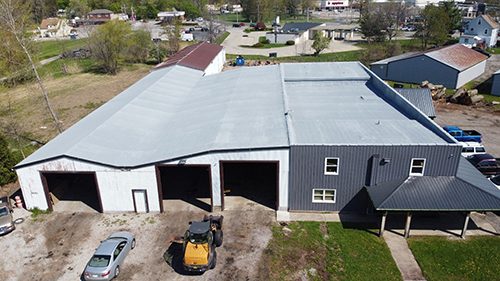
The size of your roof
The larger your roof is, the less it’ll cost per square foot. This is due to the safety setup and the overhead costs on every roof.
For example, a 1,000-square-foot roof could cost $12 per square foot. A 100,000-square-foot roof could cost $6 per square foot.
It’s the same as buying a 24-pack of paper towels versus a 4-pack; which one is less expensive per roll?
Manufacturer material costs
Roofing contractors buy spray foam from manufacturers. Spray foam pricing is volatile. You might see on your quote that the current price is valid for only a short time.
This is usually because material costs increase.
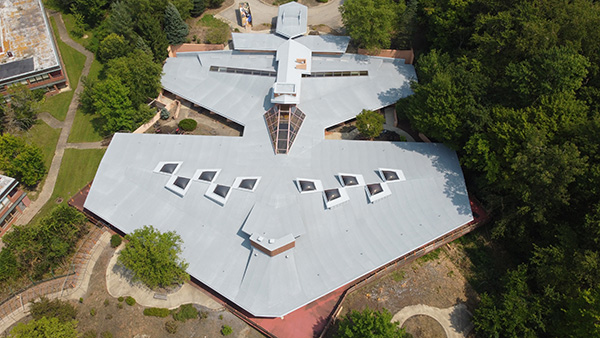
The Difficulty of Installation
Some roofs require man lifts or other types of extensive safety equipment that may need to be rented for the job.
Some roofs are harder to work on, which requires more labor hours than others.
Condition of the existing roof
One of spray foam’s best advantages over other roofing systems is that it always minimizes tear-off. In most cases, spray foam can be installed over your existing roof.
However, sometimes there may be more prep work due to existing conditions.
Here are a few things that can happen:
- If you already have two roofing systems installed, at least one must be completely removed before installing any other roofing system (including spray foam).
- No roofing system can (or should) be installed over wet insulation. If you have wet insulation, it needs to be removed and replaced before installing another roof system. This can be 5% or 100% of your roof. An infrared inspection and/or the pulling of core samples will determine the amount of wet insulation the roof has.
- A spray foam roof must be installed over a fully adhered existing roof system. If your existing roof isn’t fully adhered, a coverboard may need to be installed before spray foam can be installed. An example is a TPO roof that’s only attached to the insulation below at the seams. In this example, a coverboard would be needed.
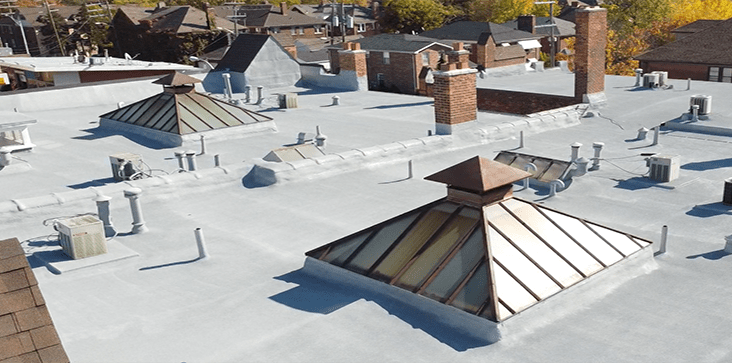
The thickness of spray foam
The more foam used for your roof, the more costly it’ll be.
Spray foam must be installed at least 1” thick to cure and perform properly. However, most roofs require more than 1”.
You might be wondering…why some roofs require more spray foam than others.
A roof that needs to be completely removed down to the deck is considered “new construction” under the building code. This means there’s a minimum R-value requirement.
In Ohio, it’s an R-25.
Because spray foam has an average R-value of 6.5 per inch, about 4 inches of foam would need to be installed.
If a roof has ponding or standing water that doesn’t run off, there may be a sloping issue. One of the best advantages of spray foam is that spray foam is fluid-applied.
This means adding slope is very easy…just pull the trigger and install more product. Other roofing systems must cut the membrane and make the slope with insulation boards, which is time-consuming and expensive.
A common installation (on a roof with an internal draining system) is 2 inches of spray foam around the perimeter and all penetrations and 1 inch of foam near the drains.
Some buildings, such as IT companies and chemical plants, are more stringent about climate control. These buildings use more cooling/heating than normal businesses do. In this case, a higher R-value may be targeted, requiring more spray foam.
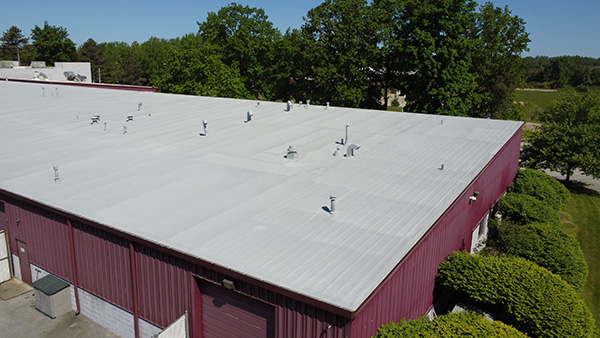
The thickness of the coating and warranty length
After spray foam is installed, a protective, “elastomeric” coating must be installed. Coatings protect the spray foam from UV rays, which can degrade the foam. The most common elastomeric coating is silicone.
The warranty length varies with the amount of coating installed.
- For a 10-year warranty, 20 mils of coating are installed.
- For a 15-year warranty, 25 mils of coating are installed.
- For a 20-year warranty, 30 mils of coating are installed.
The more coating that’s used, the more the project will cost.
Access to the roof
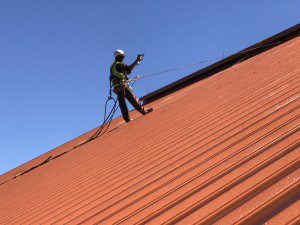
WRS Employee Rappelling for Sloped Roof Installation
Not all commercial roofs are flat; not all roofs can be walked on. Additional costs can occur when your contractor has limited access to the roof.
The roof’s height and distance can influence your installation’s cost. Sloped roofs often require the contractors to use a man lift or rappelling gear for installation.
Contractors may need to rent conveyance equipment, such as a crane or passenger hoist, to move the crew and equipment.
When teams work in secure locations, such as airports, they often need to update their Secure Identification Display Area (SIDA) authorization. This includes background checks and fingerprinting, an added cost for the contractors.
Distance from the spray foam roofing contractor
The further away you are from the contractor, the higher the project’s price will be.
Gas, vehicle wear and tear, flights, and hotel stays can all affect the cost of your commercial roof installation.
It’s worth noting that the most important aspect of choosing the best contractor for your job is one who installs the best quality roof.
It would be completely un-cost-effective to choose a contractor who’s right down the road from you, yet installs a $100,000 roof that needs to be replaced in a few years.
What should you do now?
Now that you know about cost, what about the other questions you might have, such as:
- What problems can spray foam roofs have?
- How does a spray foam roof compare to a single-ply roof?
- How long will a spray foam roof last?
Here are a few case studies on spray foam roofs we’ve installed:
Metzenbaum Center – Learn how re-covering a roof with spray foam came in under budget while completing the job in 1/3 of the time.
MTD – Learn how 3 spray foam robots and a 14-person crew finish a 384,000 sq. ft. spray foam roof in 52 days.


